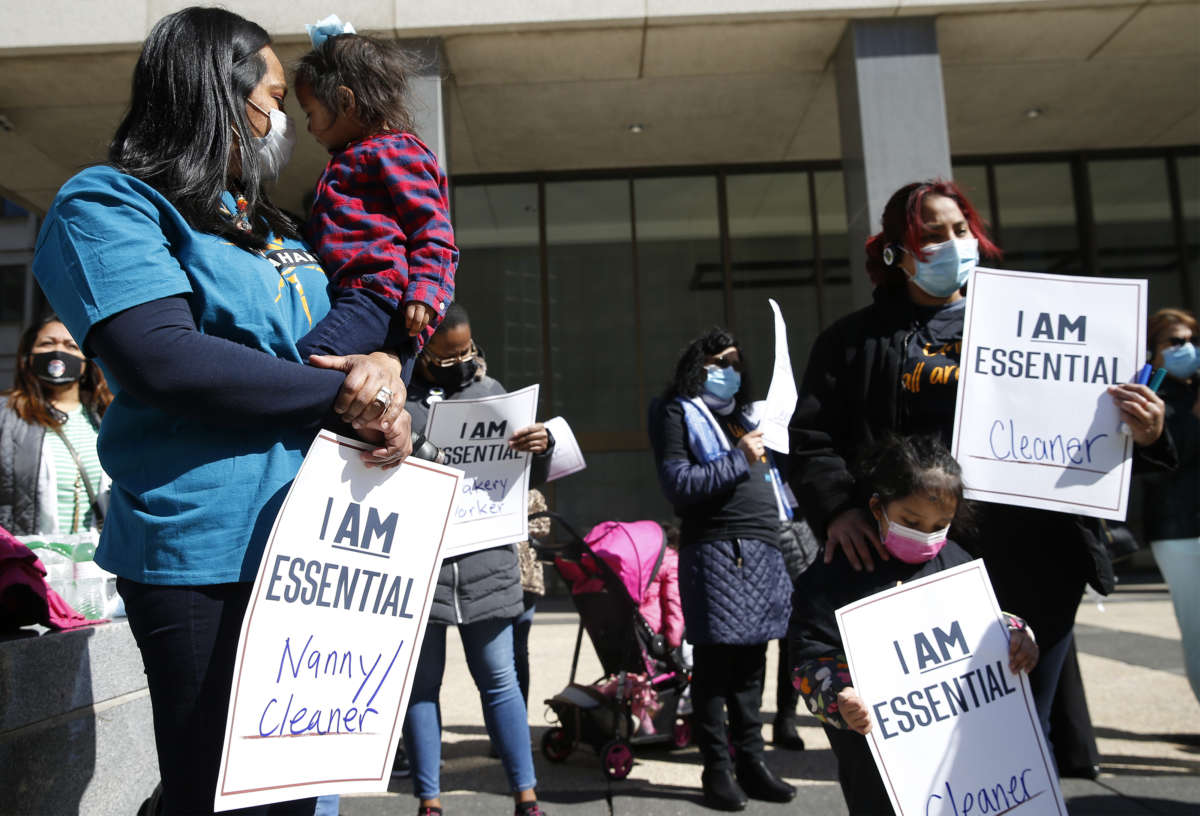The pandemic shut down child care centers across the country. It’s no coincidence that it also sent unemployment rates soaring among women, especially those with young children.
That’s not only the conclusion of many mothers, but also of a recent study by the Centre for Economic Policy Research.
The unusual events of the last year broadly expanded the number of women facing child care crises, but this problem predated COVID-19, fueled by racial inequity and the gender wage gap.
“Low paying jobs with unaffordable child care creates a demographic that’s already in trouble and really poor,” said Mary C. King, an economics professor at Portland State University. “Among those particularly are women of color being disproportionately affected in front-line, face-to-face service work, which are the low-paying jobs that got hit first with unemployment.”
One in four working women — 15.5 million in all — has a child younger than 14 at home, according to the Brookings Institution. More than 10 million of these women rely on child care and school for their children while they’re at work.
The 2020 recession was the first on record in which women’s unemployment rates rose significantly more than men’s, prompting some to call it the “shecession.”
Even before the pandemic hit, nearly half of all working women in the U.S. held low-paying jobs with a median wage of $10.93 an hour, according to Brookings. These positions — often known as “pink collar” jobs and common among women of color — make women more susceptible to poverty. Over 50% of Black and 64% of Hispanic women are paid low wages, Brookings said, compared with 40% of white women.
“The lack of child care infrastructure is finally impacting white, middle-class mothers who, historically, have been able to buy their way out of child care crises in this country,” said Katie B. Garner, executive director of the International Association of Maternal Action and Scholarship. “Mothers impacted by a lack of child care are mostly essential workers who work outside the home, and before the pandemic, many of them barely pocketed enough to cover child care in the first place.”
Big differences in income and job flexibility by race also meant many more white mothers than mothers of color had child care alternatives they could turn to when the pandemic hit, said Nina Smith, an associate professor at North Carolina Central University.
“These can include things like juggling home care with a partner, taking a break from employment or working from home,” Smith said.
During the first two months of pandemic shutdowns, mothers with children age 13 or younger reduced their work hours five times as much as fathers, according to the Centre for Economic Policy Research. Many mothers weren’t laid off. They had no choice but to stop working and care for their young children.
The latest coronavirus relief bill put $24 billion toward emergency funds for the child care industry, $160 billion toward reopening schools safely and $1,400 per child in direct payments to parents. That provides some help to women with unmet child care needs, though experts say it won’t solve the problem.
“While COVID may have been a wake-up call to white mothers and white families, I hope that there is a very deep realization and understanding that this has been an ongoing problem,” Garner said. “Black and brown mothers have been dealing with this for such a long time.”
We’re not backing down in the face of Trump’s threats.
As Donald Trump is inaugurated a second time, independent media organizations are faced with urgent mandates: Tell the truth more loudly than ever before. Do that work even as our standard modes of distribution (such as social media platforms) are being manipulated and curtailed by forces of fascist repression and ruthless capitalism. Do that work even as journalism and journalists face targeted attacks, including from the government itself. And do that work in community, never forgetting that we’re not shouting into a faceless void – we’re reaching out to real people amid a life-threatening political climate.
Our task is formidable, and it requires us to ground ourselves in our principles, remind ourselves of our utility, dig in and commit.
As a dizzying number of corporate news organizations – either through need or greed – rush to implement new ways to further monetize their content, and others acquiesce to Trump’s wishes, now is a time for movement media-makers to double down on community-first models.
At Truthout, we are reaffirming our commitments on this front: We won’t run ads or have a paywall because we believe that everyone should have access to information, and that access should exist without barriers and free of distractions from craven corporate interests. We recognize the implications for democracy when information-seekers click a link only to find the article trapped behind a paywall or buried on a page with dozens of invasive ads. The laws of capitalism dictate an unending increase in monetization, and much of the media simply follows those laws. Truthout and many of our peers are dedicating ourselves to following other paths – a commitment which feels vital in a moment when corporations are evermore overtly embedded in government.
Over 80 percent of Truthout‘s funding comes from small individual donations from our community of readers, and the remaining 20 percent comes from a handful of social justice-oriented foundations. Over a third of our total budget is supported by recurring monthly donors, many of whom give because they want to help us keep Truthout barrier-free for everyone.
You can help by giving today. Whether you can make a small monthly donation or a larger gift, Truthout only works with your support.
